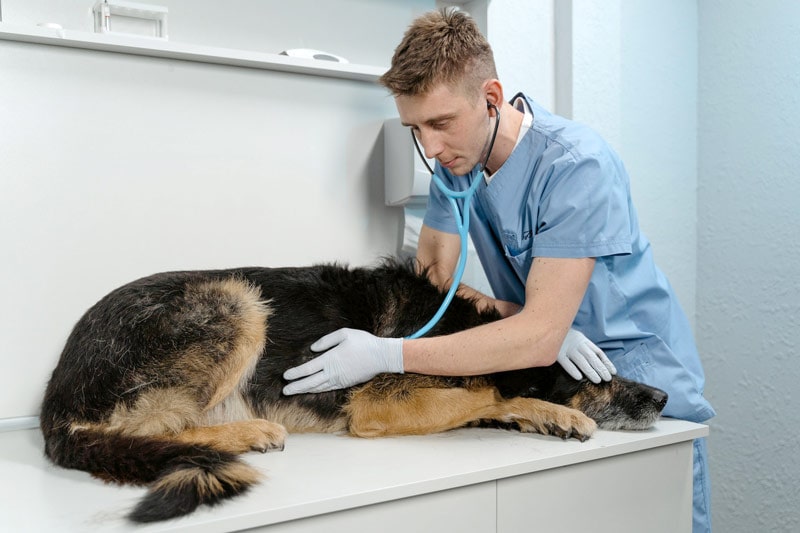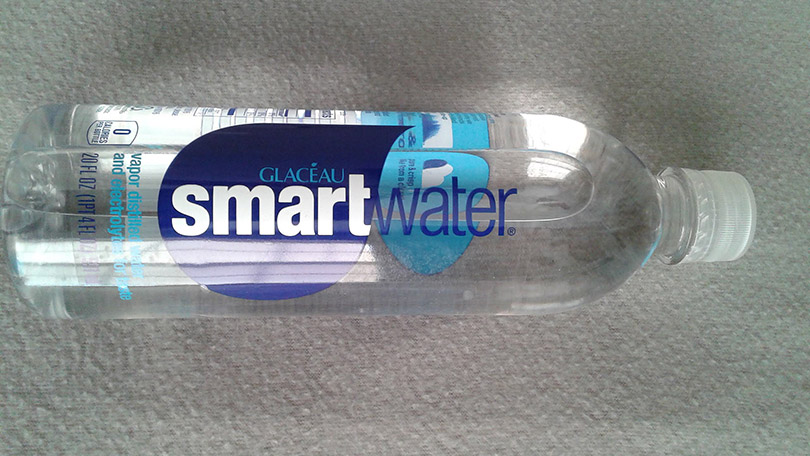My Dog Ate a Magnet: Here’s What to Do (Vet Answer)

Updated on

Click to Skip Ahead
If your dog gets a hold of a magnet, it may not be too much of a surprise to find that this item can be a potential health hazard to them! If you witness your pup eating a magnet or have evidence to believe that they may have gotten ahold of some, there are some things to do and not to do.
Below, we’ll discuss those factors, emergency lifesaving information if choking occurs, as well as the management of the event if a magnet is consumed.
Immediate Steps to Take
- Take away any other possible magnets or metal items that may be around from being munched on. As we’ll learn shortly, the only thing much worse than one magnet is two!
- Contact as soon as possible: Your veterinarian or local emergency veterinary clinic and/or veterinary poison control. Some examples include the Pet Poison Helpline or the ASPCA Poison Control. These companies are always open and employ board-certified veterinary specialists in toxicology. They can give a pet owner a recommendation when something abnormal, such as a magnet, has been eaten.
- Try to gather any evidence you can from the situation to show the veterinarian; for example, if there are magnetic toy letter pieces from the fridge chewed up on the floor- these are clues to help piece together what exactly the dog ate and around how much.

Things Not to Do:
- Don’t panic. Losing emotional control will prevent you from being your dog’s best advocate.
- Don’t delay dealing with the situation. The sooner potential treatment can occur, the better chance for success. In addition, it will be less likely for secondary medical conditions to develop that can be even more dangerous for your dog.
- Do NOT induce at-home vomiting with your dog unless specifically instructed by a veterinarian. Your dog’s vet will want to assess the situation, the size and health status of the dog in question, what they may have consumed, the timing of the situation, and more. In addition, some substances should not be purposely thrown back up as they can be caustic, choking hazards, etc.
Emergency Choking and How to Handle It
Because both magnets and dogs can vary in size, it’s reasonable to expect that if a magnet is being eaten or being vomited back up, there’s a possibility that choking could unluckily come into play.
Signs of choking include coughing, having trouble breathing, gasping for air, pawing at their face, excessive drooling, or acting panicked. The affected dog may start to lose consciousness and their gums can turn from pink to white or blue. This is an absolute emergency!
If choking, some steps can be attempted to remove the item, such as a magnet, in question. This is all with the caveat to attempt only if you can do so without the risk of being bitten and ensuring to not push the item further into the dog’s throat. In addition, if there is anyone around you to whom you can call out for help, they may be able to contact your nearest veterinary clinic, help you if needed, and provide a ride as care is continued to get you to the nearest open hospital.
- You can pull the dog’s tongue out towards yourself and use your hand to carefully pull out the object.
- Alternatively, you may open the dog’s mouth and use sweeping motions with your fingers to grab the item in question and pull it outward.
- You could also try to use an item such as tweezers or tongs to attempt to obtain the item.

Heimlich Maneuver
Small dogs: Pick up the dog so their back is against your front. Have your arms go around the dog under their ribs and find the soft abdominal area along their stomach just below their ribcage. Next, using a fist, press inwards and upwards gently five times. Then place your dog down and check for the item in question. Repeat the process as needed.
Larger dogs: If they are standing, you can attempt the Heimlich maneuver above with them upright. If they are laying down or so large that you are unable to place them against your front, you can put a hand along their back with the other hand pressing inwards and upwards along their stomach just below the ribcage five times. Again, you’ll want to check for the item they’ve been choking on in their mouth and repeat if unsuccessful.
Perform Cardiopulmonary Resuscitation (CPR)
To get blood flow and oxygen delivery to the body, CPR can be performed, which is about 30 chest compressions and then two rescue breaths and repeat.
- Stand behind the dog; for smaller animals use one hand, and for larger use two hands with interlocked fingers.
- Keep elbows and arms as straight as possible with your shoulders over above your hands.
- For chest compressions, you’ll want to compress between ⅓ and ½ of the dog’s chest width.
- Try to do 100–120 chest compressions in a minute which is about two compressions every second.
- For the rescue breath, close your dog’s mouth and have their airway be as straight as possible.
- Next, seal your mouth over the top of your dog’s nose and nostrils and give a hard and fast breath, pause for potential exhalation, and give the second breath.
- Ideally, this should be continued until you can get to the nearest veterinary hospital or resolve the matter.
If you would like more detailed instructions or a picture or video format on the above techniques, there are additional resources available. As always, it’s best to look for information from a reputable source.
Magnet Expectations and Management
Depending on how large the dog is in addition to the size of the magnet, how many magnets there are, and where these objects are located, will all help to determine the next course of action. In addition to these factors, you also must factor in the veterinarian’s options and your ultimate decision/resources. A key step to help diagnose magnet consumption is an X-ray to confirm if a magnet and/or metal object(s) were consumed as well as the quantity. The good news is these objects typically show up fabulously on X-rays! Other imaging such as ultrasound may also prove to be helpful.
Sometimes the magnet may be too heavy to do much other than sit in the stomach and cause irritation. Other times the magnet may cause a foreign body obstruction (an object that is eaten and stuck in the digestive tract that blocks the flow of digested material). And because some types of magnets may prove to be more corrosive than others, it’s hard to know exactly what will happen in any given situation.
If a single magnet has been eaten, there’s a chance it won’t be too much of a problem; but the bigger problem occurs when more than one magnet has been eaten. In this case, or if a magnet and another metal object are in the body together, major problems can result. Because magnets can produce a magnetic field over a distance that pulls or repels other magnets or metallic materials to it, these magnetic forces can move the digestive tract around and/or prevent the regular flow of consumed material.
In fact, eating two magnets or a single magnet and another metal or metallic object has presented problems in dogs such as gastrointestinal (GI) foreign bodies, GI necrosis (death of tissue), GI perforations (a hole that forms in the tissue or organ), and other secondary problems due to sepsis (infection, such as with bacteria, that causes a large problematic response within the body), etc.
Because of the potential for future issues, it’s best to get the magnet out to prevent a problem from occurring. Again, if there is more than one magnet, this is even more imperative. Whether the removal is via endoscopy (using a long flexible tube and camera that can visualize and attempt to obtain the sample in question) or a laparotomy (exploratory surgery into the abdominal area)—it’s best to take action before a dog is very sick. The longer there are medical issues, the higher the likelihood of complications resulting in an even sicker dog that may prove to be harder to treat.
If you are looking for signs that your dog may have a foreign body obstruction or other gastrointestinal issue due to magnet consumption, these could include continual vomiting, not wanting to eat, lethargy, weakness, depression, and sometimes even a painful abdomen. This situation requires medical intervention and time is of the essence.
Overall, with early and successful treatment, these affected dogs can have a good prognosis. If a dog is very ill due to magnets being stuck in the digestive tract for a while, you can imagine that the prognosis is not as good as time goes on.

Prevention
While it’s easy to say that prevention is the best medicine, it really is easier, better, and less expensive to avoid accidental consumption of harmful objects to begin with. It’s good general practice to make regular checks and sweeps for items in your home that could be potential target problems for your dog. This could include magnetic and metal items such as refrigerator magnets, toys that have magnets in them, office supplies, and items around the house such as paper clips, screws, other tools, etc.
Conclusion
If your dog eats a magnet, the potential effects are difficult to predict and could range from nothing all the way to death. The likelihood of major problems goes up even more if there is more than one magnet or a magnet and another metal object consumed due to magnetic forces.
If your dog eats a magnet, it’s best to remain calm and quickly call your veterinarian for your best next step.
See Also:
- My Dog Ate a Lizard: Vet-Approved Advice & FAQ
- My Dog Ate a Slug: Here’s What to Do (Vet Approved Advice)
Featured Image Credit: Pla2na, Shutterstock













